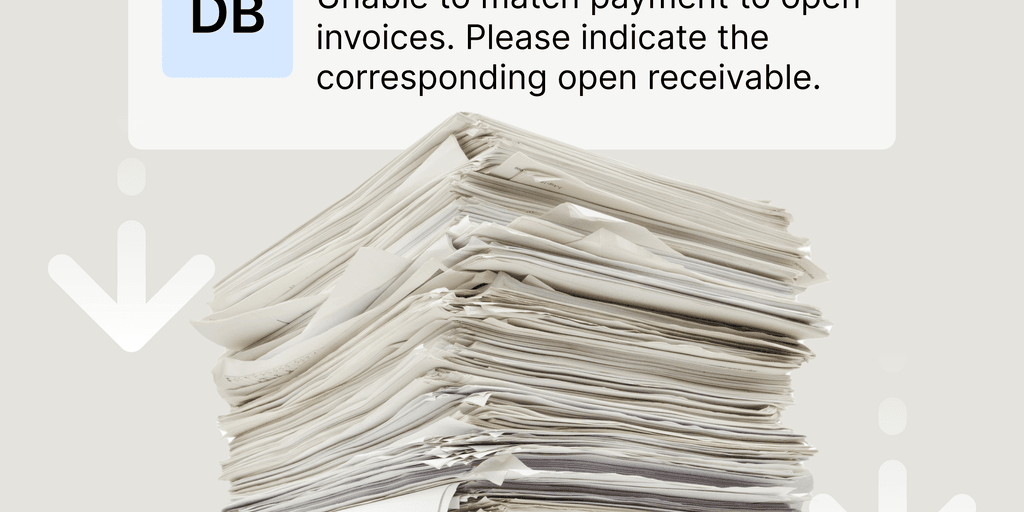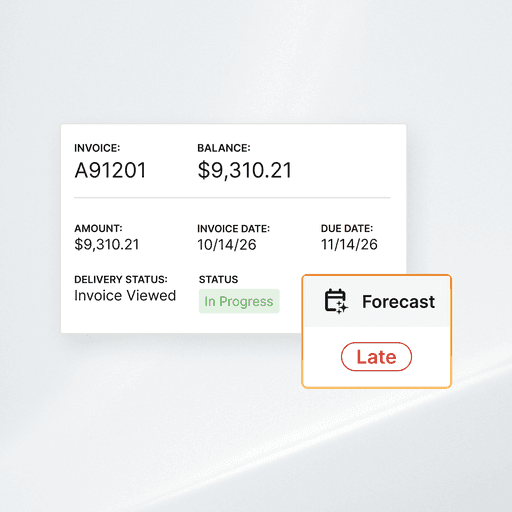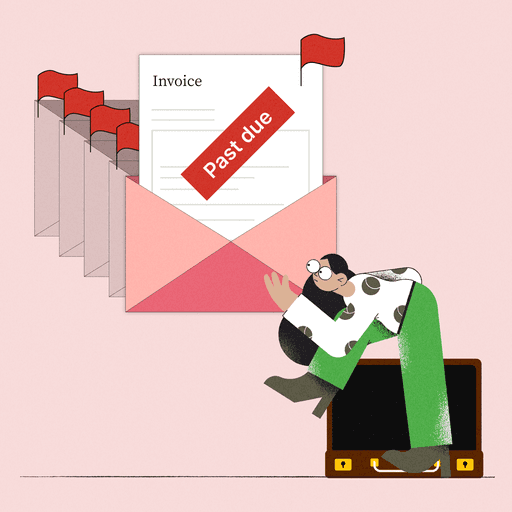
How to Improve Your Dunning Process in Accounts Receivable
- 9 min read
The dunning process has long been an essential function of accounts receivable. But dunning letters may be hurting your AR process.
In this blog, you’ll learn:
- What dunning letters are
- Why dunning letters are harmful
- How to improve your dunning process
- And more

The dunning process has long been an essential function of accounts receivable, but that doesn’t mean the process works well for most organizations. In fact, the dunning process is overdue for an overhaul to make it more efficient. Optimizing this process is important due to the high importance of ensuring invoices are paid on time.
An efficient and reliable invoicing process that succeeds at prompting on-time payments has many benefits beyond simply making sure your revenue is in-hand. It also:
- Promotes better customer relationships
- Allows for improved cash flow forecasting, and
- Takes less effort from your accounts receivable (AR) team, freeing up their time for higher-value tasks.
Improving the efficiency of your AR process requires going beyond dunning letters. Adding standardization, templates, and automation to your process will improve it immensely. Read on to learn how dunning letters may be hurting your AR process and how the dunning process as a whole should be re-imagined for maximum benefit.
Jump to a section of interest:
What are dunning letters?
Dunning letters are collection notices that inform customers that their payment-due is past its deadline. These letters are typically used by collections teams to prompt payments on delinquent accounts and reduce days sales outstanding (DSO) to ensure steady cash flow.
AR teams usually issue multiple dunning letters in a series until the customer makes payment. After a few notices, the business will typically notify the customer that fees are being added to their account.
4 reasons dunning letters are hurting your AR process
Dunning letters are not the most effective vehicle for ensuring a healthy AR function, since they are formal, one-way communications with customers. And unfortunately they’re used so heavily, as effective communication is crucial throughout the collections process—and dunning letters do not deliver on that front:
- Some 35% of businesses say the quality of customer communication is one of the biggest roadblocks for their collections, according to SSON and Versapay’s 2022 AR Pulse Check survey of 103 finance and business services leaders.
- Additionally, 85% of C-level executives report that poor communication has directly resulted in customers not paying their bills, according to a survey of 1,000 executives Verspay ran with Wakefield Research.
Here are four reasons that relying on a dunning process to prompt payment is harmful for your business.
1. Dunning processes based on letters tend to be inflexible
Dunning letter protocols are formal and by nature limit potential conversation about payment terms or payment plans. They are an isolated, single touch point with customers, which does the opposite of encouraging a cooperative, collaborative solution to the problem.
This method also doesn’t tend to allow for flexibility in methods of payment, as the letter typically instructs the customer to pay in a specific way by a specific time.
2. Dunning letters lead to poor customer experience
According to the 2022 AR Pulse Check survey, more than 95% of respondents see customer experience as important to the AR process. But dunning letters are impersonal and don't lend themselves to creating enjoyable payment experiences for the buyer.
They are typically sent by email, which is a clunky communication method that customers have a hard time tracking. Additionally, today’s tech-savvy customers want options for payment, particularly digital options, which dunning letters don’t provide.
3. Using dunning letters puts AR in a reactive position
The dunning letter protocol is typically triggered by a buyer becoming behind on payment, which means that after the initial invoice the customer doesn’t hear from the company until they receive a rebuke-style letter.
Waiting to communicate until there’s a problem puts AR teams in a reactive position instead of allowing them to take more future-looking action. Companies that communicate with buyers more often and more proactively can set up a positive, cooperative relationship with customers that can recoup payments faster.
4. Creating dunning letters wastes staff time
Sending dunning letters is repetitive, tedious work. It takes up staff time that could be used on tasks that will add more value to the business, such as strategic planning and longer-term projects.
Removing the rote, manual work from the collections process helps make AR more efficient. It’s no surprise that 92% of C-level respondents to the Wakefield survey strongly agree that digitizing AR is crucial to reaching their organization’s peak performance.
6 signs that your accounts receivable process needs help
Now that you know the many pitfalls of the dunning process, it’s time to look at your own AR set-up and identify the red flags. Here are 6 signs that your accounts receivable process could use a transformation:
- High volume of payments past-due: If you have a high number of customers who haven’t paid by their deadlines, your AR process may be too impersonal, inflexible, hostile, disorganized, or inefficient.
- Growing number of delinquent accounts: An increasing number of customers who don’t pay on time indicates a problem with the methods you’re using to prompt payment, whether it’s how you communicate, what options you provide for them to pay, or the general attitude your team takes toward collections.
- Low open rates or engagement in response to letters: It’s a problem if your dunning letters are being ignored, since customers who never see your warnings won’t get the reminder and won’t know the consequences of inaction.
- High customer attrition and/or complaints: A recent survey of 400 finance leaders (link to data coming soon) found that 37% of finance and business leaders see the finance department as being a big contributor to negative customer experience, and 43% identify collections cycles as a major reason for that.
- High card declines due to outdated information: An AR process that is not able to maintain updated payment information typically leads to inadvertent non-payment that prompts a dunning process that could have been avoided.
- Staff dissatisfaction or burnout: The tedious, manual nature of your AR process can fuel staff unhappiness or attrition, a conclusion borne out by the finding in our ‘Digital by Design’ study that 73% of finance executives appreciate how automating AR can help attract and retain accounting and finance talent.
How to improve dunning processes (and AR as a whole) through automation
There are two main steps to improving your dunning process, which is part and parcel of improving your entire AR function. First, start with making basic improvements to your process to make it less tedious and time-wasting. Then set up a collaborative AR process using targeted software tools. Here’s how to proceed:
1. Do basic standardization and automation
If you’ve never standardized your dunning process, that’s the first order of business. You should have a set of standard collections email templates that everyone on your AR team uses in a specific order on a specific timeframe. Each letter in the progression should say the exact same thing for every customer, and these should be stored in a shared drive where everyone can copy the latest version to insert into their email communications.
Once you have the missives templated, it’s time to do some basic automation. You should set up automated collections notifications and automated dunning emails so that your staff doesn’t have to waste time starting the same process from scratch each time. You can set up a workflow that will do a lot of the heavy lifting.
2. Set up a collaborative payment process
After you’ve got your dunning process running smoothly, it’s time to move away from it altogether by transitioning to a collaborative payment process. This is a digitized AR function centered on a shared, cloud-based customer payment portal that enables self-service payment via several methods. Customers can sign into the portal to track their payment due dates, make payments, communicate directly with the AR team, and download supporting documentation.
Collaborative AR software has many useful features that save AR teams time, encourage timely payment, and make customers more satisfied, including:
- Proactive communication to prompt payment before delinquency
- Real-time communications and dispute management
- Notifications for AR teams to help manage the process
- Centralized visibility into customer interactions
- Actionable insights to help AR teams prioritize customer outreach
- Detailed reporting and customer management in a single location
Embracing a collaborative approach to AR delivers more value than dunning letters alone ever could, as all communication—including late-payment notifications—can reach customers through the portal.
AR automation can transform your collections
The key to faster, more efficient, more cooperative collections is turning your customers into your collaborative partners instead of your financial adversaries.
The dunning process is not collaborative, which ensures it will present problems in getting customers to pay and spark customer dissatisfaction. It also tends to be manual, requiring a lot of staff time and resulting in employee burnout.
But this doesn’t have to be your reality. AR automation software can transform your collections process, improving it and your customer experience in multiple ways at once. Check out our guide to accelerating collections to learn more about what these tools can do for you.
About the author

Katie Gustafson
Katherine Gustafson is a full-time freelance writer specializing in creating content related to tech, finance, business, environment, and other topics for companies and nonprofits such as Visa, PayPal, Intuit, World Wildlife Fund, and Khan Academy. Her work has appeared in Slate, HuffPo, TechCrunch, and other outlets, and she is the author of a book about innovation in sustainable food. She is also founder of White Paper Works, a firm dedicated to crafting high-quality, long-from content. Find her online and on LinkedIn.


